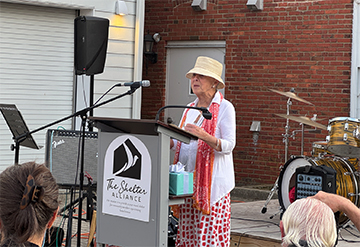The Garfield Center for the Arts is bringing new life to The Elephant Man, Bernard Pomerance’s powerful drama about Joseph Merrick, a man with severe deformities who was long exploited as a sideshow attraction before finding dignity and recognition in Victorian society. First staged in 1977, the play went on to win the Tony Award for Best Play and became an international success for its stark theatrical device: Merrick is portrayed without prosthetics, relying on the actor’s physicality and the audience’s imagination to confront their own assumptions about beauty, cruelty, and compassion. Its revival at the Garfield underscores both the timelessness of the play’s themes and the theater’s commitment to presenting work that challenges as well as entertains.
The Spy recently caught up with the play’s director, E.T. “Talley” Wilford, and actor Ben VanNest, who plays Joseph Merrick, the Elephant Man.
“The Elephant Man” opens this Friday and runs Friday and Saturday nights at 8 PM, and Sundays at 2 PM, until October 19th. For tickets, visit www.garfieldcenter.org anytime, or call 410-810-2060 on Wednesdays, Thursdays or Fridays from 10 AM to 3 PM.
This video is approximately five minutes in length.






 I came to know Yana that spring, after the Russian occupation ended, when I was contracted to design a children’s book raising awareness and support for Ukraine. As part of the agreement, I was to help select a Ukrainian artist to create more than a dozen color illustrations for the manuscript by Dr. Janice Cohn, a children’s book author and psychotherapist. Janice, a donor to the Ukraine Children’s Action Project (UCAP), contacted the organization’s co-founder, Dr. Irwin Redlener to see if they could recommend a Ukrainian artist. She was then put in touch with UCAP’s Regional Director, Yuliia Kardash, who spent many hours researching artists who might be suitable for the project, and finally recommended Yana. After reviewing Yana’s work, Janice and I agreed she was the perfect choice. Our correspondence began soon after.
I came to know Yana that spring, after the Russian occupation ended, when I was contracted to design a children’s book raising awareness and support for Ukraine. As part of the agreement, I was to help select a Ukrainian artist to create more than a dozen color illustrations for the manuscript by Dr. Janice Cohn, a children’s book author and psychotherapist. Janice, a donor to the Ukraine Children’s Action Project (UCAP), contacted the organization’s co-founder, Dr. Irwin Redlener to see if they could recommend a Ukrainian artist. She was then put in touch with UCAP’s Regional Director, Yuliia Kardash, who spent many hours researching artists who might be suitable for the project, and finally recommended Yana. After reviewing Yana’s work, Janice and I agreed she was the perfect choice. Our correspondence began soon after.
 Since neither of us spoke the other’s language, Yana and I labored through a translation app to agree on how each illustration would appear using both her innate artistic intuition and scene requirements (complex positioning of multiple people, expression, etc.) on our part. And, for all I knew, despite cross-checking, a word in the Ukrainian app expressing “joy” could have been slang for “potato.” But she was kind, and rather than pointing out a translation problem simply asked for clarification. Some of the illustrations would take several more versions.
Since neither of us spoke the other’s language, Yana and I labored through a translation app to agree on how each illustration would appear using both her innate artistic intuition and scene requirements (complex positioning of multiple people, expression, etc.) on our part. And, for all I knew, despite cross-checking, a word in the Ukrainian app expressing “joy” could have been slang for “potato.” But she was kind, and rather than pointing out a translation problem simply asked for clarification. Some of the illustrations would take several more versions. Janice’s new narrative grew out of her “conviction that kindness and compassion can steady children in even the darkest times, and that in helping others, we often find our own resilience.” The book became a parallel story about two children, a boy, Artem, escaping Ukraine with his mother, and a girl, Hannah, in America who became determined to raise funds for the war-torn country. Chapters became counterpoint narratives about each child’s experience.
Janice’s new narrative grew out of her “conviction that kindness and compassion can steady children in even the darkest times, and that in helping others, we often find our own resilience.” The book became a parallel story about two children, a boy, Artem, escaping Ukraine with his mother, and a girl, Hannah, in America who became determined to raise funds for the war-torn country. Chapters became counterpoint narratives about each child’s experience. For Janice, the book became more than a story—it became a reminder that even small acts of care can repair the world. Yana eventually received some copies of the book.
For Janice, the book became more than a story—it became a reminder that even small acts of care can repair the world. Yana eventually received some copies of the book.